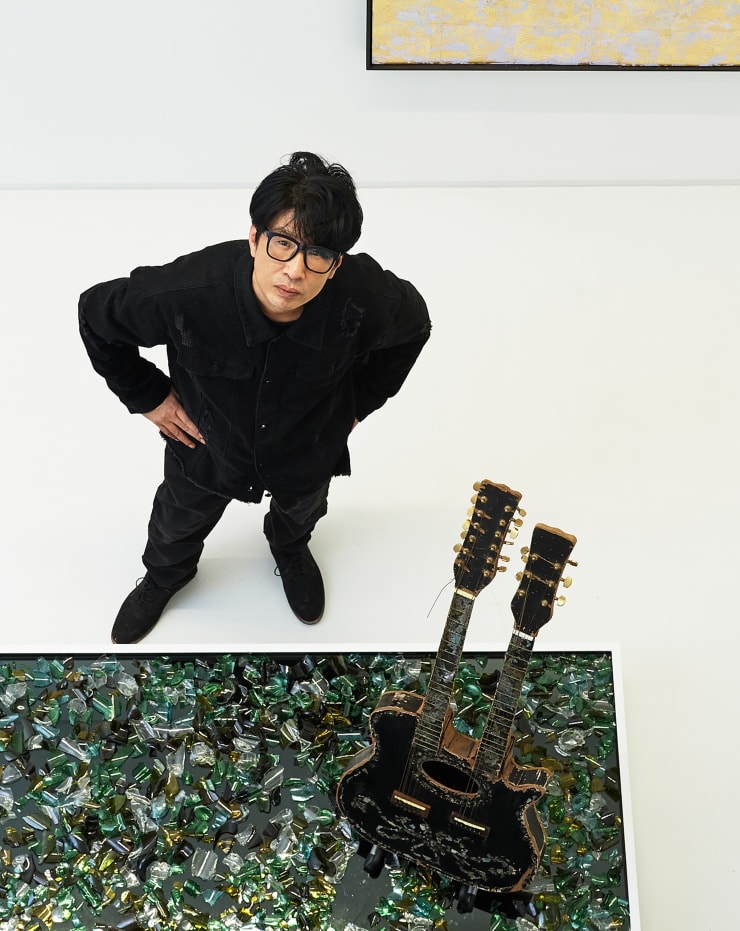BAE YOUNG-WHAN: SO NEAR SO FAR
-
ABOUT
-
So Near so far
21 march - 4 may 2024
SOLO EXHIBITION OF
Bae Young-whan
PRESS RELEASE →
BB&M is pleased to present So Near So Far, a solo exhibition of new work by Bae Young-whan. Recognized for a practice that melds a keen awareness of vernacular beauty to neo-conceptual strategies, Bae is a key figure in the influential, albeit loosely defined, post-minjung generation of Korean artists who emerged in the late 1990s grappling with the legacies of Korea’s turbulent modernity. Often making use of humble, mundane elements (discarded material from construction sites, broken bottles, sentimental song lyrics), his art is attuned to the ephemeral surfaces of lived experience as well as the deeper structures of feeling that underlie Korean society.
The present exhibition is centered around wall works that elaborate on his long-standing preoccupation with language, in particular the demotic of popular music. Some of the artist’s most recognized works from the late 1990s to early 2000s delved into the way sentimental Korean pop song lyrics from his youth were sublimated into a common poetry of resistance against an authoritarian society. Composed of abject materials like broken liquor bottles on beat-up wooden panels, they also spoke to a peculiarly Korean strain of self-destructive, self-romanticizing masculinity.
The works in So Near So Far expand the parameters of Bae’s subject to more universally familiar songs that have attained an iconic status for a generation of (mostly) male devotees, like the artist himself, weaned on vinyl LPs. Pink Floyd’s “Wish You Were Here,” Neil Young’s “Heart of Gold,” and David Bowie’s “Space Oddity” — first encountered as pirated contraband in the stalls of Cheonggyecheon, Seoul’s traditional market for electronic goods, that the artist frequented in his youth — serve as a departure point for a series of works delineating the contours of his mind, via EEG readings taken as he performed the unmistakable opening notes on a guitar.
The result, rendered in 3-D reliefs assembled into abstract panels with expanses of translucent painted layers and gold-leafed crests and ridges, is aptly titled Mindscapes. This term finds its correlative in shimsang (literally “an image in the mind”), a central concept in the tradition of Asian landscape painting that resonates with Bae’s practice. As the artist has observed, it is “an interpretation of a scene shaped by your individual consciousness — quite a radical notion in what’s usually thought of as a conservative genre.”
Sustaining that ideal image of the world may be the central project of Bae’s art, even as some of his work evinces a more visceral sense of loss and existential drift experienced by his generation. A counterpoint to the wall works, an installation in the main gallery brings together rough-hewn guitars on a bed of shattered bottles heaped on a black-mirrored platform. The guitars are built by the artist using intricately decorated wood veneer salvaged from abandoned cabinets and vanities in old neighborhoods emptied to make way for high-rise developments. There’s also a turntable spinning a large, silent rock in place of an LP. Titled Like the First Time, the installation is a poetic acknowledgment of the impossibility of recreating the perfect note, of making something broken whole again.
Yet it somehow makes sense that the only sound in the exhibition — which revolves around music as a generative system of ideas, symbols, and language — should be the wistful, faltering notes of the guitar chords played with a true amateur’s ardor by the artist in a video that shows him hooked up to EEG sensors, his brainwave readouts blending with scenes of a mountain blanketed in freshly fallen snow.
-
SELECTED WORKS
-
RELATED CONTENT
-

